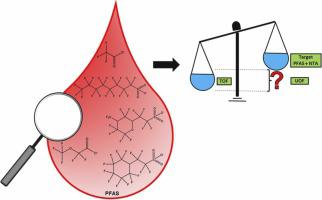Trends in Environmental Analytical Chemistry ( IF 11.2 ) Pub Date : 2023-12-26 , DOI: 10.1016/j.teac.2023.e00224 Dilani Perera , Wesley Scott , Rachel Smolinski , Leenia Mukhopadhyay , Carrie A. McDonough

|
Per/polyfluoroalkyl substances (PFASs) are a class of ubiquitous environmental contaminants associated with several adverse health effects in humans and animals. Liquid chromatography with tandem mass spectrometry (LC-MS/MS) has traditionally been used to provide targeted quantitation of PFASs in biological samples. The analyte lists covered by targeted LC-MS/MS methods have grown rapidly as more PFASs have been discovered, though not all organofluorine is amenable to this technique. Integrative techniques measuring total organofluorine (TOF) coupled with LC-MS/MS analysis demonstrate that a significant fraction of TOF in biological samples is not captured by LC-MS/MS. This missing organofluorine may be contributed by PFASs that are not amenable to typical PFAS analytical conditions. Here, we review recent progress in quantifying total PFAS burden and identifying the compounds that comprise the unidentified organofluorine fraction (UOF), with a focus on human biological samples. While LC coupled to high-resolution mass spectrometry (LC-HRMS) has identified several novel PFASs in biological samples, these efforts do not appear to fully explain UOF content. Closing the UOF gap will necessitate the development of additional analytical approaches to broaden the chemical space captured by PFAS analysis. We highlight the use of additional chromatographic methods, advanced separation approaches such as ion mobility spectrometry (IMS), and continued improvement of HRMS semi-quantitation methods as promising paths forward to close the UOF gap.
中文翻译:

表征生物样品中 PFAS 负荷的技术:最新见解和仍然存在的挑战
全氟烷基物质/多氟烷基物质 (PFAS) 是一类普遍存在的环境污染物,与人类和动物的多种不良健康影响相关。液相色谱串联质谱 (LC-MS/MS) 传统上用于对生物样品中的 PFAS 进行靶向定量。随着更多 PFAS 的发现,目标 LC-MS/MS 方法涵盖的分析物列表迅速增长,但并非所有有机氟都适用于该技术。测量总有机氟 (TOF) 的综合技术与 LC-MS/MS 分析相结合表明,生物样品中很大一部分 TOF 未被 LC-MS/MS 捕获。这种缺失的有机氟可能是由不适合典型 PFAS 分析条件的 PFAS 造成的。在这里,我们回顾了量化 PFAS 总负荷和识别构成未识别有机氟成分 (UOF) 的化合物的最新进展,重点关注人类生物样本。虽然液相色谱与高分辨率质谱联用 (LC-HRMS) 已鉴定出生物样品中的几种新型 PFAS,但这些努力似乎并不能完全解释 UOF 含量。缩小 UOF 差距将需要开发额外的分析方法来扩大 PFAS 分析捕获的化学空间。我们强调使用额外的色谱方法、离子迁移谱 (IMS) 等先进的分离方法以及持续改进 HRMS 半定量方法作为缩小 UOF 差距的有希望的途径。



























 京公网安备 11010802027423号
京公网安备 11010802027423号